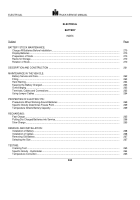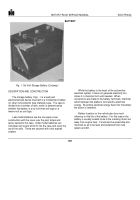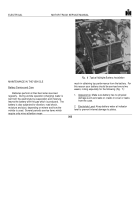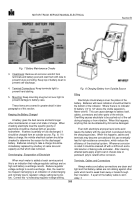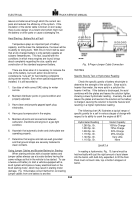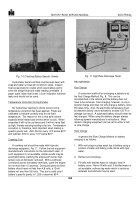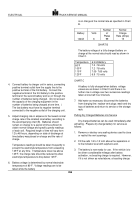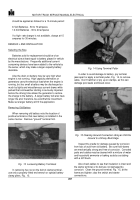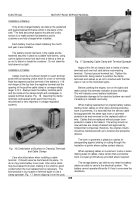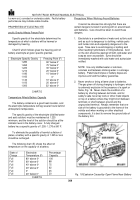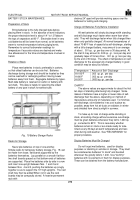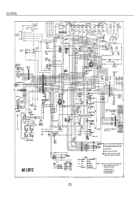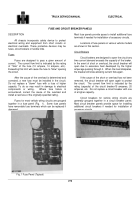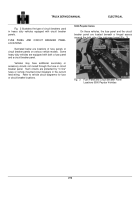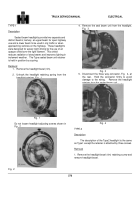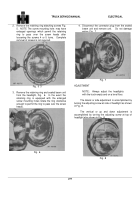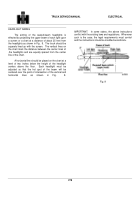TM-5-3805-254-14-P-2 - Page 274 of 894
ELECTRICAL
MOTOR TRUCK SERVICE MANUAL
BATTERY STOCK MAINTENANCE
Preparation of Stock
Bring batteries to the fully charged state before
placing them in stock.
In the absence of level indicators,
the proper electrolyte level is about 1/4" to 1/2”Itabove
the tops of separators at 80
°
F.
Electrolyte level in very
cold batteries will be lower than normal, so let batteries
warm to normal temperature before judging levels.
Remember to correct hydrometer readings for
temperature if accurate values are desired and make
due allowances for the time and temperature involved in
transit.
Rotation of Stock
Place new batteries in stock, preferably in cartons,
so that oldest batteries can be sole first.
Batteries
discharge during storage and should be located so they
can be reached for recharging without moving newer
batteries away from them.
Segregate batteries by types.
Mark date battery is received on carton or battery with
red chalk.
This date is helpful in selecting the oldest
battery of any type in stock for earliest sale.
Fig.
19 Battery Storage Racks
Racks for Storage
Never pile batteries on top of one another.
Simple racks for temporary battery storage, Fig.
19, can
be made from loose, flat boards supported by the
batteries themselves.
Lay parallel on a smooth flat floor
two shelf boards spaced so that bottom ends of batteries
are supported.
Place five batteries side by side in a row
and insert one upright between Nos.
1 and 2 and
between Nos.
4 and 5, pushing the batteries up snugly
together so as to support the 10" high uprights.
The next
shelf may then be added When not in use the rack
boards may be compactly stored.
A heavier permanent
rack with
shelves 24" apart will provide working space over the
batteries for testing and charging.
Charge All Batteries Fully Before Installation
All wet batteries will slowly discharge whil4 standing
and will discharge much faster when warm than when
cold.
They will discharge faster when fully charged than
when only partially charged.' At normal temperatures of
about 70-80
°
F loss of capacity by self-discharge, starting
with a fully charged battery, may amount to an average
of about .
001 sp.
gr. per day over a 30 day period.
At
the start it may amount to .002 sp.
gr.
loss per day and
gradually taper off to less than .
001 sp. gr. loss per day
by the end of 30 days.
The effect of temperature on self-
discharge for the average fully charged battery in good
condition may be about as follows:
Temperature
Amount of Self- Discharge
At 100°F
.003
sp. gr.
per day
At 80°F
.002 sp. gr.
per day
At 50°F
.0005 sp. gr.
per day
CHART F
The above values are approximate for about the first
ten days of standing after being fully charged.
Some
makes of batteries have a higher or lower state of self-
discharge than the above, depending on method of
manufacture and purity of materials used.
To minimize
self-discharge, store batteries in as cool a place as
possible, away from hot air ducts or radiators in winter
and shielded from direct sunlight in summer.
To make up for loss of charge while standing in
stock, a boosting charge without excessive overcharge
must be given batteries whenever they fall to 1.240 sp.
gr., corrected to 80
°
F.
This is necessary whether
batteries remain in stock or are made ready for sale.
Check every 30 days at warm temperatures and less
often during cold weather.
See "RECHARGING" for
proper procedure.
Display Batteries Must Be Charged
Do not forget wet batteries.
used for display
purposes or standing in vehicles in storage.
They must
be considered as batteries "in stock" and boosted
whenever the gravity falls to 1.240.
Use "dummy"
batteries with no elements in them for display purposes.
These can be obtained from the battery manufacturer.
270
Back to Top

